
Survey research is a valuable tool for collecting data from a specific group of people to gain insight into topics of interest. This methodology involves asking the predefined group of people questions on one or several issues. In this article, we’ll delve into the meaning and application methods of survey research, while also proving you with numerous examples and helpful tips.
Definition: Survey research
The primary aim of survey research is to collect information about the characteristics and opinions of specific individuals or groups through questionnaires or interviews. This quantitative research method allows researchers to obtain insights into various trends or relationships within a population, thereby facilitating decision-making, hypothesis testing, and theory development across diverse fields. Survey researchers carefully plan to draw conclusions and use them to guide future actions or research projects.
Why use survey research?
Surveys are widely used across various fields for several reasons, and it serves many purposes. In this paragraph, you’ll find out why survey research is beneficial and its most common uses.
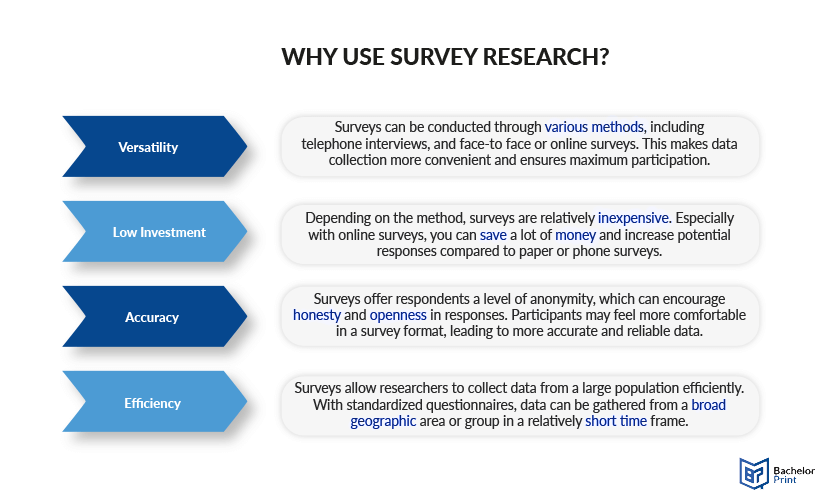
Common uses
The most prevalent uses of survey research include:
- Market research: Gathering information about consumer preferences, purchasing behavior, brand perception, and market trends. Businesses use survey data to make informed decisions about pricing strategies and advertising campaigns.
- Political science: Gauging public opinion on various political issues, candidates, and policies. Polling organizations conduct surveys to measure voter preferences, track changes in public sentiment over time, and predict future election outcomes.
- Social research: Studying social behaviors and beliefs concerning topics such as social inequality, family structures, cultural values, and social networks. The data helps understand societal trends and challenges of different social groups.
- Psychology: Researching personality traits, mental health, and behavior patterns to assess psychological constructs and measure symptom severity. Surveys are also used in developmental psychology to study child development, parenting practices, and family dynamics.
Types of survey research
Survey research can be classified into three main types: exploratory, descriptive, and causal. Understanding the distinctions between these formats is essential, as the type chosen becomes the backbone of your campaign. It guides the design of your study, shapes the methodologies employed, and ultimately determines the depth and breadth of insights gained from the data collected.
Exploratory
Exploratory survey research
Exploratory research is a type of research methodology conducted to explore and investigate a research question or issue that is generally not well understood or lacks clear definitions. This type of study is typically conducted at the early stages of a research process, when there is limited existing knowledge concerning the interest or where the problem is unclear, and sets the foundation for a research campaign.
It aims to generate a hypothesis or uncover new phenomena for further investigation, and can be divided into primary and secondary research. Primary research is conducted by interviewing study participants directly, through interviews or social media, whereas secondary research is data that has been collected and published prior by another source, such as books and articles. The latter is typically used to gain an overview of a topic.
Exploratory survey research may involve specific strategies such as:
- Open-ended questions: Questionnaires with open-ended questions allow respondents to provide detailed and unrestricted responses, These responses can offer valuable qualitative data, providing insights into participants’ perspectives, and experiences on the topic of interest.
- Focus groups: One of the most common uses of exploratory research since they provide researchers with a great foundation on where the target sample group stands on an issue. They are easy to organize and the focus group‘s dynamic and body language can guide additional research on the topic.
- Interviews: Researches may conduct qualitative interviews with individuals, which provide an opportunity for in-depth exploration and can uncover nuances and insights not captured by quantitative survey questions alone. They can be conducted by phone or in person.
- Observation: Observing participants’ reactions and body languages to questions or new products, for instance, allows researchers to capture real-time behaviors during interviews, providing context-rich data for exploration.
Below you’ll find example questions for an exploratory survey research, and a list of pros and cons.
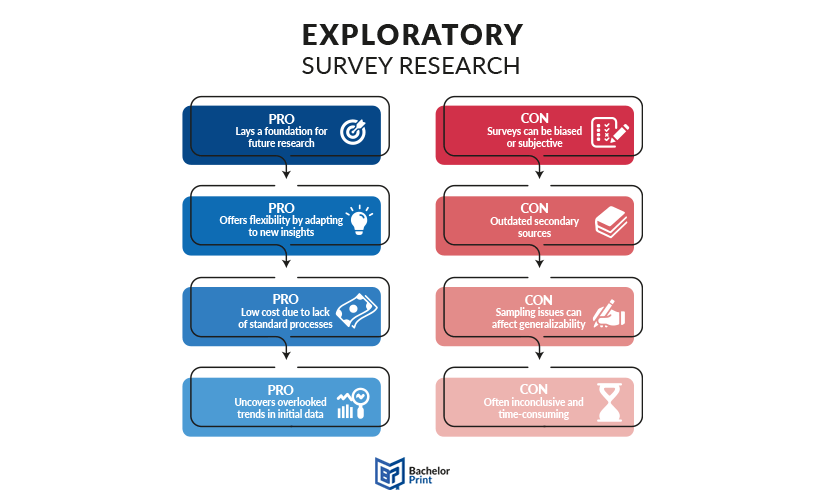
Descriptive survey research
Descriptive research is the most common form of survey research as it aims to systematically measure and categorize opinions and beliefs held within a population. This method of quantitative research paints a picture of a topic and its existence, without delving into the underlying reasons why something exists or occurs, which is why it’s used as a starting point to quantitative research. This focus contrasts descriptive research with other types of research that may seek to understand causality or motivations.
The study will help essentially uncover patterns, but not necessarily why those exist. There are three different approaches for this type of descriptive research: descriptive surveys that gather information, descriptive-normative surveys that gather information and then compare the result with a norm, and finally correlative surveys that explore the relationships between two variables and conclude if it’s positive, neutral, or negative.
Descriptive survey research often involves key strategies such as:
- Sampling techniques: Often uses sampling techniques to select a representative sample from the intended population of interest. Common sampling methods include simple random sampling, stratified sampling, and cluster sampling, which ensures that the sample accurately reflects the characteristics of the larger population.
- Questionnaire design: Researchers carefully craft clear and unbiased survey questions to collect relevant data. Close-ended questions with predefined response options are commonly used to facilitate data analysis, but open-ended questions may also be included to gather qualitative insights.
- Pilot testing: Before administering the survey to the target population, researchers conduct pilot testing with a small group of participants to evaluate the comprehensibility and relevance of the survey questions. Pilot testing helps identify and address any issues with wording, response options, or format.
- Data analysis: Once the survey data is collected, researches analyze the data using descriptive statistics to summarize and describe the characteristics of the sample. Descriptive statistics such as frequencies and percentages are used to present key findings and identify patterns or trends within the data.
In the following section, you’ll find example questions for a descriptive survey research, along with an illustration determining the pros and cons of it.
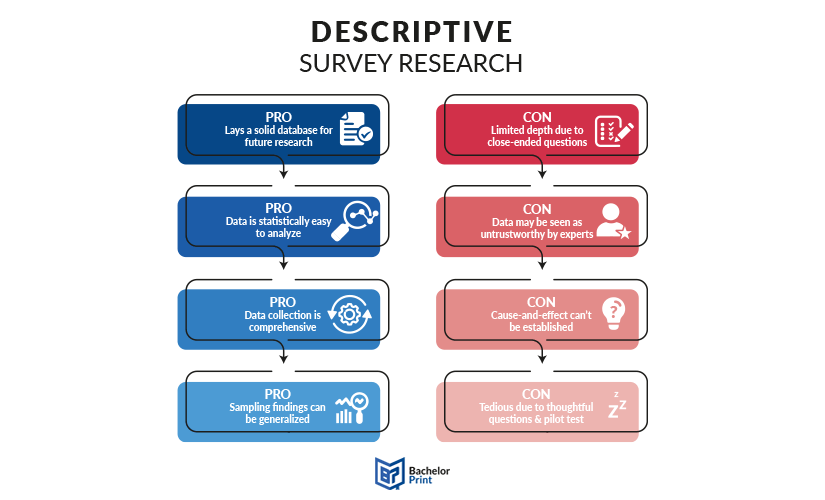
Causal survey research
Causal research (also known as explanatory research) is a type of conclusive research that aims to uncover cause-and-effect-relationships between two or more variables. Similar to descriptive research, this form attempts to prove an idea, however casual research’s objectives are to determine which variables are the cause, and which ones are the effect, as well as the nature of the causal relationship between the two. This purpose makes causal research more scientific than its exploratory and descriptive counterparts, and is often used to assess the impact of changes in products or features.
Causal survey research often involves certain procedures such as:
- Experimental design: It typically employs experimental designs where researchers manipulate one or more independent variables to observe their effect on dependent variables. Random assignment of participants to experimental and control groups helps minimize bias and establish causality.
- Controlled variables: To establish causality, researchers control for unaccounted-for variables that may influence the relationship between the depended and independent variables. This helps isolate the effects of the manipulated variables on the outcomes of interest.
- Hypothesis testing: Causal survey research involves formulating hypotheses about the relationship between variables and testing these hypotheses using statistical analysis techniques such as regression analysis, ANOVA, or structural equation modeling.
- Longitudinal study: A causal survey may involve longitudinal studies that track participants over time to assess the long-term effects of manipulated variables on dependent variables. This allows researchers to observe changes and strengthen causal interference.
In the following section, you’ll find example questions for a causal survey research, as well as an illustration of pros and cons that come with it.
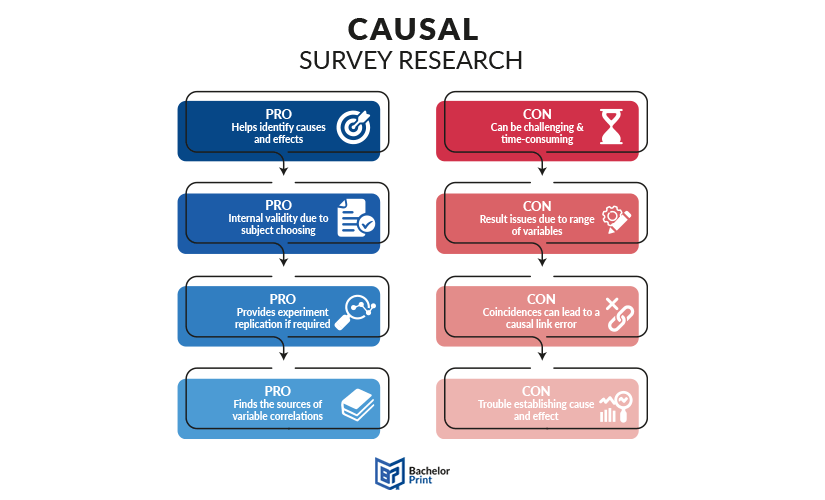
Survey research methods
Two important factors can be used to determine methods for survey research: the time taken for the survey and the tool you choose to conduct it.
Time
In terms of time, there are two main types of survey research: longitudinal survey and cross-sectional survey. Both will be explained textually and visually below.
A longitudinal survey research is a type of study design in which data is collected from the same subjects repeatedly over a long period of time. This allows researchers to observe changes, behaviors, trends, or developments over time, typically through multiple waves of data collection procedures spaced out at regular intervals.
A cross-sectional survey research is a study design in which data is collected at a single point in time from a diverse group of individuals or subjects. This type of research provides a snapshot or “cross-section” of the broader population at a specific moment, allowing researchers to examine patterns or characteristics. Cross-sectional surveys are often used to compare different groups or explore associations between variables, and can either be descriptive or analytical.
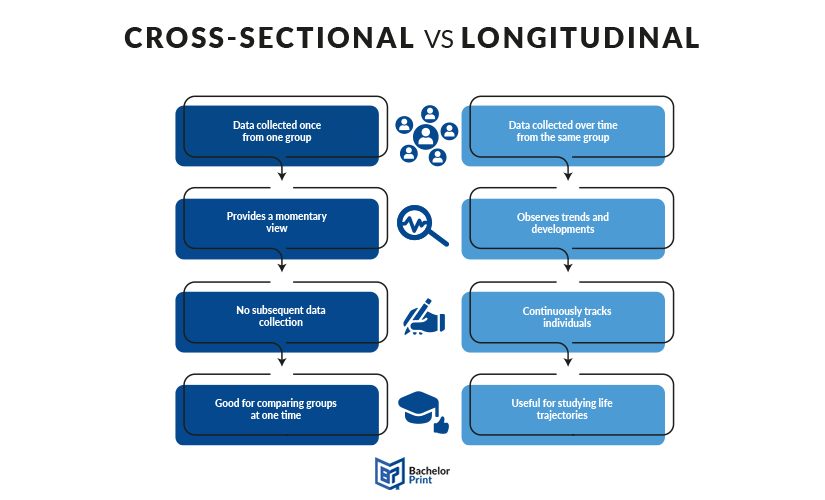
Tool
Regarding the tool used for survey research, there are two types you can choose from: a questionnaire and an interview. Each one will be explained below.
A questionnaire is a research instrument used to gather data from a group of respondents. In the past, questionnaires could only be printed out on paper, with the analysis process starting after collecting all the responses. Due to the rise of the Internet and online survey instruments, this process can be done more cost-effectively and time-efficiently.
-
Mail
Questionnaires administered via mail involve sending printed survey forms to respondents through postal mail. The questionnaire typically includes a cover letter explaining the purpose of the survey, instructions for completion, and a prepaid return envelope for respondents to send back their completed surveys. This method offers convenience for respondents to complete the survey at their own pace and in their own environment. However, it may suffer from low response rates, potential delays in data collection, costly due to printing and mailing, and challenges in ensuring the accuracy of returned surveys.
-
Online
Online questionnaires are administered electronically through web-based survey platforms or email invitations with links to the survey. This type of questionnaire offers several advantages, including rapid data collection, global reach, minimal cost, and automated data processing. They also allow for customization, real-time monitoring of response rates, and easy dissemination through various channels. However, online surveys may encounter issues such as nonresponse bias, technical glitches, and limited accessibility for certain populations.
A structured interview involves direct interaction between the researcher and the respondent, allowing for in-depth exploration of topics and capturing nuanced insights. Unlike questionnaires, interviews employ open-ended questions more often, enabling respondents to elaborate on their experiences and viewpoints. Interviews can be conducted in-person, over the phone, or through video conferencing, providing flexibility in data collection. While interviews offer richer qualitative data and opportunities for rapport-building, they can be resource-intensive and time-consuming, particularly for larger samples.
-
In-person
In-person interviews involve face-to-face interaction between the interviewer and the interviewee in the same physical location. This method allows for direct observation of nonverbal cues, such as body language and facial expressions, which can provide additional context to responses. In-person interviews foster rapport and trust between the two parties, allowing for more in-depth exploration of topics. They are suitable for situations where personal interaction and nuanced understanding are essential, but they may require more time and resources for travel and logistics.
-
Phone
Telephone interviews are conducted over the telephone or smartphone, where the interviewer asks questions and records the respondent’s answers. This method offers flexibility and convenience for both parties, as interviews can be scheduled at a mutually convenient time without the need for travel. Phone interviews can be cost-effective and efficient for reaching geographically dispersed participants. However, they lack visual cues and nonverbal communication, which may limit the depth of understanding the rapport between the interviewer and respondent. Another disadvantage can be, that nowadays many people feel uncomfortable sharing their phone numbers and are less open to an interview via phone.
-
Video conferencing
Video conferencing interviews are conducted using platforms such as Zoom, Skype, or Microsoft Teams, allowing for real-time audio and visual communication between the interviewer and interviewee. This method combines the benefits of in-person and phone interviews, offering face-to-face interaction while overcoming geographical barriers. Video conferencing interviews enable observation of nonverbal cues and visual aids, enhancing communication and understanding. They are suitable for remote data collection methods, collaborative research projects, and situations where personal interaction is desired, but travel is impractical.
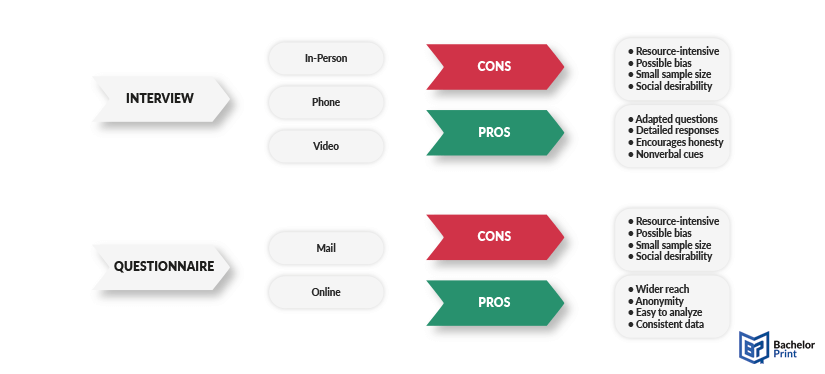
Survey research questions
Before selecting the design for survey research, it is advisable to fully examine each of your alternatives. Below, you’ll find some of the most common forms of survey questions with an example each.
Multiple choice questions
They present respondents with a set of predefined options from which they must select one or more answers that best fit their response. This format is commonly used to gather structured data efficiently and allows for easy analysis.
Likert scales questions
Likert scale questions measure the degree of agreement or disagreement using a scale of response options. They provide a quantitative measurement of respondent’s attitudes or opinions on a given topic.
Matrix questions
Matrix questions, also known as grid questions, present respondents with a series of related items or statements that share a common set of response options. They are useful for collecting data on multiple related variables or dimensions in a structured and efficient manner.
Open-ended questions
An open-ended question is one that prompts respondents to provide a free-form response, allowing them to express their thoughts or opinions in their own words. Unlike close-ended questions, which offer predefined response options, open-ended ones encourage respondents to provide detailed and qualitative responses.
Demographic questions
A demographic question is one that collects information about respondents’ demographic characteristics, such as age, gender, income, education, or ethnicity. This question type helps researchers categorize, and segment respondents based on relevant demographic variables, allowing for deeper analysis and understanding of survey results. They are typically straightforward and objective, aiming to collect factual information rather than opinions or attitudes.
Step-by-step guide
The following is a step-by-step guide that will help you perform your study efficiently.

Define your research objectives
The first step in every survey research is to determine a subject of interest. Depending on your research question, you need to identify the target audience of your survey. This means that you need to determine the specific information you must collect and the population you want to study, as the survey should be generalized.

Choose your survey method
Select the most appropriate survey method based on your research objectives, target audience, resources, and logistical considerations. The most common survey methods include online surveys, mailed questionnaires, face-to-face interviews, or a combination of these different approaches.

Design your survey questions
Survey research design can include several types of questions, which include single or multi-response questions, as well as open and closed questions. In most cases, people like to take part in survey research that has short, concise questions. Consider the order, wording, and response options of questions to ensure clarity and accuracy.

Select your sampling method
Choose an appropriate sampling methodology to select a representative sample from the entire population you wish to study. Options include stratified sampling, random sample, systematic sampling, or snowball sampling, depending on your research objectives and readily available sources.

Monitor & analyze data
Monitor the data collection process to ensure that surveys are being completed accurately. Track response rates and follow up with non-respondents if necessary. After gathering all the data, you may create charts and graphs to provide a quick reference to your results. You may also utilize text analysis as well as a word cloud on open-ended questions, which will help you pinpoint the common response trends in your survey research.

Writing a report
The result you get from your analysis will be beneficial in writing a concluding report. In this research report, you should summarize your survey methodology, key findings, interpretations, and conclusions. Include your tables, charts, graphs, or narrative summaries to present your results effectively. Write clearly and concisely, and consider the needs of your intended audience when formatting and presenting your report.
Tips for a perfect survey research
Use the following tips to create an effective survey research that will provide conclusive results.
- Clearly define objectives
Start by clearly defining your research objectives. What specific information are you trying to gather, and how will it contribute to your goals?
- Design effective questions
Craft clear and unbiased questions that are relevant to your research objectives. Use a mix of question types (e.g., multiple-choice, open-ended) to gather comprehensive data.
- Pilot test your survey
Before launching your survey, conduct a pilot test with a small sample of respondents to identify any issues with clear language and balanced framing.
- Maintain data quality
Implement measures to ensue data quality throughout the survey process, including data validation checks (e.g., valid email, right phone number digits), attention checks, and monitoring for incomplete or inconsistent responses.
- Provide incentives
An incentive is helpful in attracting people to respond to your survey and gives them a reason to help you out. It can come as a gift card or money.
- Choose the right methodology
Select the most appropriate survey method based on your research objectives, target population, and available resources. Do you prefer using the interview or questionnaire method?
- Sample size and method
Determine the appropriate sample size and sampling method to ensure your results are statistically valid and representative of the target audience.
- Seek feedback
Solicit feedback from your colleagues, friends, or family for improvement in your survey research. Letting someone proofread your survey is beneficial before you share your work so that you can continuously strive for excellence.
FAQs
The three types of survey research are exploratory survey research, descriptive survey research, and causal survey research. They each serve distinct purposes and are often used in combination to address survey research questions from different perspectives or to build upon each other’s findings.
The four most common four types of surveys are:
- Face-to-face surveys
- Telephone surveys
- Mail surveys
- Online surveys
Survey research is particularly well-suited for measuring public opinions on a wide range of issues, gathering opinions about products or brands, and for studying human behavior and demographic patterns, to name a few.
An example of survey research could be a study conducted to assess public opinion polls on environmental conservation efforts in a local community. The researcher might design a survey questionnaire with questions aimed at understanding residents’ attitudes and behaviors related to environmental conservation practices, such as recycling, energy conservation, and green initiatives.
The ideal survey length should be around 10 to 15 minutes, since some people are more likely to abandon a survey if they think it’s taking too long. Generally, it should be around 10 survey questions, but this all depends on the type of survey method. Online surveys have a shorter completion time compared to telephone or face-to-face interviews.
